 |
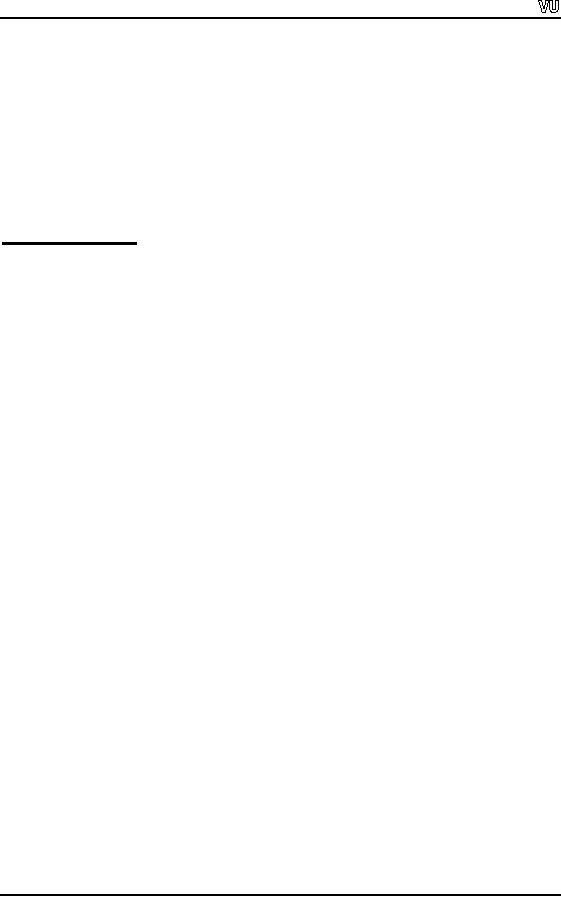
CS201
Introduction to Programming
Lecture
Handout
Introduction
to programming
Lecture
No. 5
Reading
Material
Deitel
& Deitel C++ How to
Program
chapter
2
2.4,
2.5, 2.6, 2.19,
2.20
Summary
Conditional
Statements
o
Flow
Charting
o
· Sample
Program 1
if/else
structure
o
Logical
Operators
o
· Sample
Program 2
o
Tips
Conditional
Statements (Decision
Making)
In every
day life, we are often
making decisions. We perform
different tasks while
taking
decisions.
For example, the statement
`if the milk shop is
open, bring one liter of
milk
while
returning home from college',
involves this
phenomenon.
In this
statement, there is an element of
decision making. We bring one
litre of milk if the
shop is
open. And if the shop is
closed, we come back to home
without milk.
Thus we
are making a decision on the
condition that the shop is
open. The decision-
making
process is everywhere in our daily
life. We see that the
college gives admission to
a student
if he has the required
percentage in his previous examination
and/or in the entry
test.
Similarly administration of a basketball
team of the college decides
that the students
having height
more than six feet
can be members of the
team.
In the
previous lectures, we have written
simple elementary programs.
For writing
interesting
and useful programs, we have to introduce
the decision making power
in
them. Now
we will see what kind of
decisions are there in
programming and how
these
can be
used.
Every
programming language provides a structure
for decision making.
'C' also
provides this structure. The
statement used for decisions
in 'C' language is known
as the
'if
statement'.
The if
statement
has a simple structure. That
is
Page
32
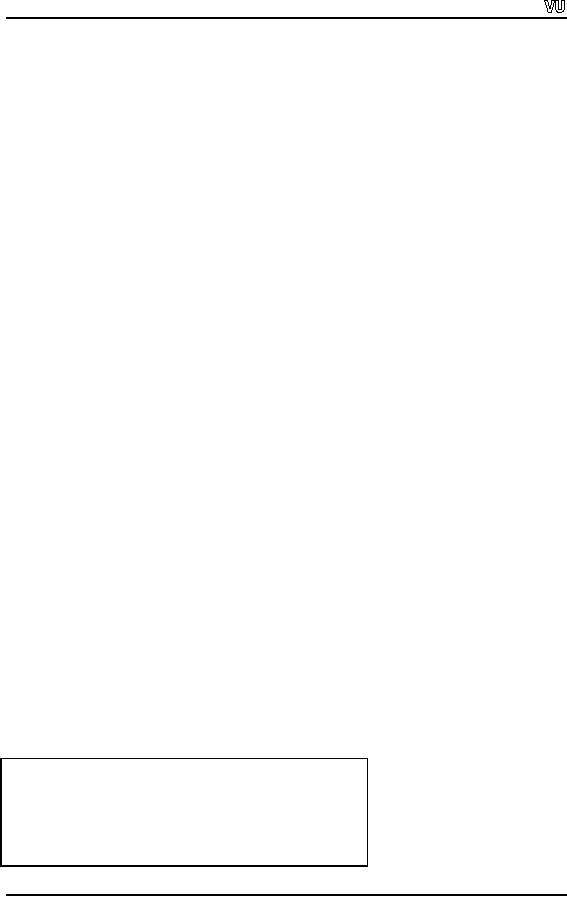
CS201
Introduction to Programming
if (
condition )
Statement
(or group of statements)
The
above statements mean, If
condition is true, then
execute the statement or a
group of
statements.
Here the condition is a statement
which explains the condition on
which a
decision
will be made. We can
understand it from the example
that Ali can become
the
member of
the basket ball team if he
has a height more than six
feet .In this case,
the
condition
will be
if
(Ali's height is greater than six
feet)
Ali
can be a member of
team
We have
written the condition in
English language. Now let's
see how we can
implement
this in
terms of variables, operators
and C statements. In the
program, we will write
the
condition
in parentheses, followed by a statement
or group of statements to be
executed.
Now
here is the concept of block
of statements. We use braces { } to
make a group
(block)
of a number of statements. We put `{'
before first statement and
`}' after the last
statement.
Thus if we have to do many things
after the if
statement.
The structure of if
statement
becomes as under
if
(condition)
{
statement;
statement;
.
.
statement;
}
Note
the indentation of the lines and
semi-colon after each statement.
Semi-colons are
necessary
after every C statement. The
indentation is only a matter of style. It makes
the
code
easy to read and understand
from where a block starts,
ends and what kind of
block
it is. It
does not affect the logic of
the program. But the braces
can affect the logic.
We
can
also write a comment line to
state the purpose of code
block.
Let's
consider a simple example to explain
the if
statement.
Suppose, we have ages of
two
students
(say for the time
being we have got these
ages in variables). These
variables are-
age1
and age2. Now we say
that if the age1 is greater
than age2, then display
the
statement
`Student 1 is older than student
2'.
The
coding for this program will
be as below
#include
<iostream.h>
main()
{
int
age1, age2;
age1 =
12;
age2 =
10;
Page
33
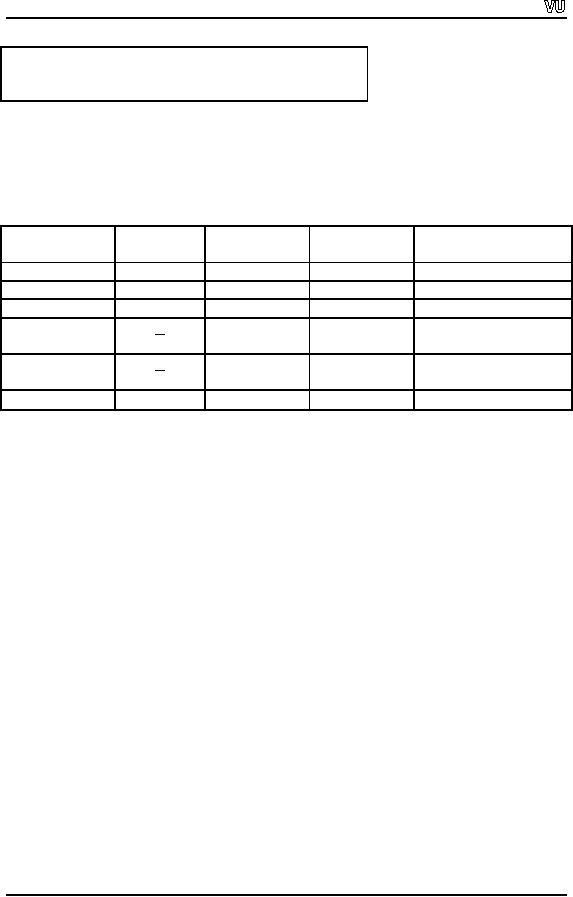
CS201
Introduction to Programming
if (age1
> age2)
cout
<< "Student 1 is older than student
2";
}
Here, in
our code we see a new
operator i.e. ` > ` (greater than) in
the if
statement.
We
need
such operators (like greater
than, less than, equal to
etc) while making
decisions.
These
operators are called 'relational
operators'. These are almost
the same relational
operators
we use in algebra. Following
table summarizes the relational
operators.
Algebraic
In
C
Example
Meaning
language
Greater
than
>
>
x>y
x is
greater than y
Equal
to
=
==
x ==
y
x is
equal to y
Less
than
<
<
x<y
x is less
than y
Greater
than or
>
>=
x >=
y
x is
greater than or
equal
to
equal to
y
Less
than or
<
<=
x <=
y
x is less
than or equal
equal
to
to
y
≠
Not
equal to
!=
x !=
y
x is not
equal to y
Note
that there is no space
between ==, >=, <= and
!=.
These
are considered as single
operators.
The
operator == (equal to) is
different from the operator
=. We know that operator =
is
the
assignment operator which is
used in assignment statement to
assign a value to a
variable.
Don't
confuse the assignment
operator (=) with equal to
operator (==). If we write
single
= in
condition of if
statement.
For example, if we write if
( x =
2 ), the compiler will
not
give
error. This means that it is
not a syntax error. The
conditional expression in if
statement
returns a value. In this
case, x = 2 will also have
some value but it will
not in
the
form of true or false. So it
will create a logical error.
So be careful while using
equal
to
condition in if
statement.
Flow
Charting
There
are different techniques
that are used to analyze
and design a program. We
will use
the
flow chart technique. A flow
chart is a pictorial representation of a
program. There
are
labeled geometrical symbols, together
with the arrows connecting
one symbol with
other.
A flow
chart helps in correctly
designing the program by
visually showing the
sequence
of instructions to be
executed. A programmer can trace
and rectify the logical
errors by
first
drawing a flow chart and
then simulating it.
The
flow chart for the
if
structure
is shown in the figure
below.
Page
34
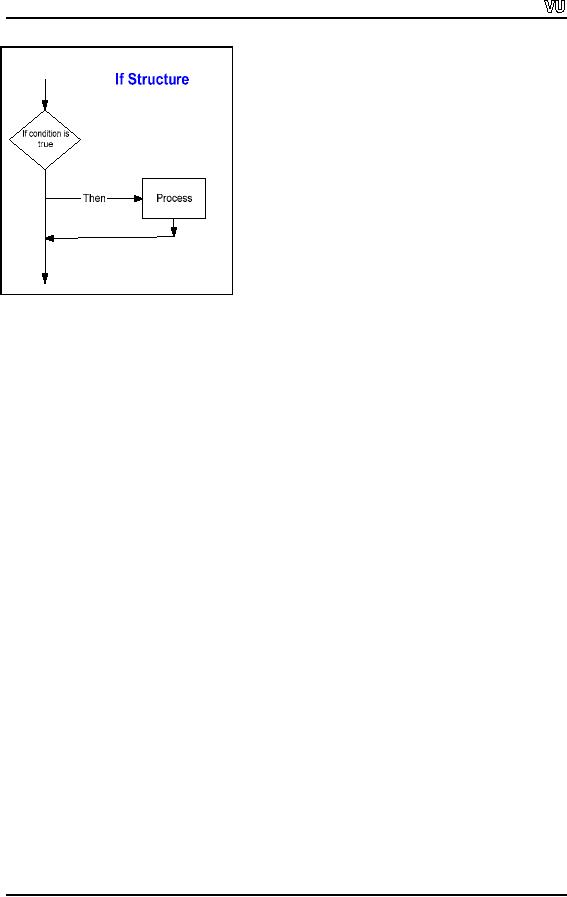
CS201
Introduction to Programming
Sample
Program 1
Now
let's see the usage of
relational operators by an example. There
are two students
Amer
and Amara. We take their
ages from the user,
compare them and tell who is
older?
As there
are two students to be
compared in terms of age, we
need to declare two
variables
to store their ages. We declare
two variables AmerAge and
AmaraAge of type
int.
The variable names are one
continuous word as we can't
use spaces in a variable
name.
Here is an
important point about
variables declaration. We should
assign an initial
value
(preferably 0
for integers) to variables
when we declare them. This is called
initialization
of
variables.
We can do
this in one line while
declaring a variable like int
x = 0; This
statement will
declare a
variable of name x with data type
int and will assign a
value 0 to this variable.
Initializing
a variable in this way is just a matter
of style. You can initialize a variable
on
a
separate line after declaring
it. It is a good programming
practice to initialize a variable.
Now we
prompt the user to enter
Amer's age and store it
into variable AmerAge.
Then
similarly
we get Amara's age from
the user in the variable
AmaraAge.
While
comparing the ages, we will
use the if
statement
to see whether Amer's age
is
greater
than Amara's. We will use
> (greater than) operator to
compare the ages. This
can
be
written as if
(
AmerAge > AmaraAge) .
With
this if
statement,
we write the statement cout
<< "Amer is greater than
Amara" ;
It's a
simple one line test i.e.
`if Amer's age is greater
than Amara's', then display
the
message
`Amer is older than
Amara'.
The
flow chart for the
above problem is as
under.
Page
35
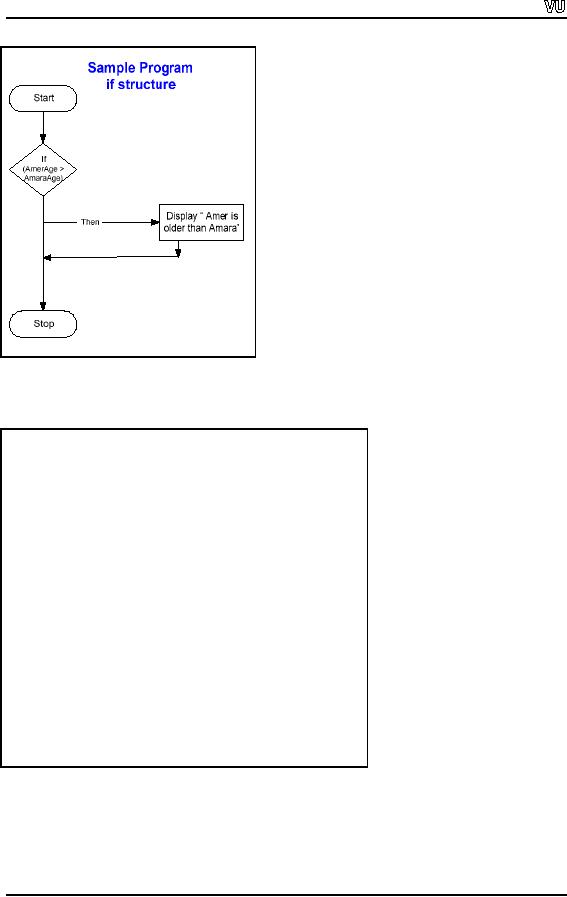
CS201
Introduction to Programming
The
complete code of the program is given
below.
/* This
program test that if the
age of Amer is
greater
than
Amara's age and displays the
result. */
# include
<iostream.h>
main (
)
{
int
AmerAge, AmaraAge;
//prompt
the user to enter Amer's
age
cout
<< "Please enter Amer's
age " ;
cin
>> AmerAge;
//prompt
the user to enter Amara's
age
cout
<< "Please enter Amara's
age " ;
cin
>> AmaraAge;
//perform
the test
if
(AmerAge > AmaraAge )
cout
<< " Amer is older than
Amara";
}
In our
program, we write a single statement
with the if
condition.
This statement
executes
if the
condition is true. If we want to
execute more than one
statements, then we have
to
enclose
all these statements in
curly brackets { }. This
comprises a block of
statements
which
will execute depending upon
the condition. This block
may contain a single
statement
just like in our problem. So we
can write the if
statement
as follow.
Page
36
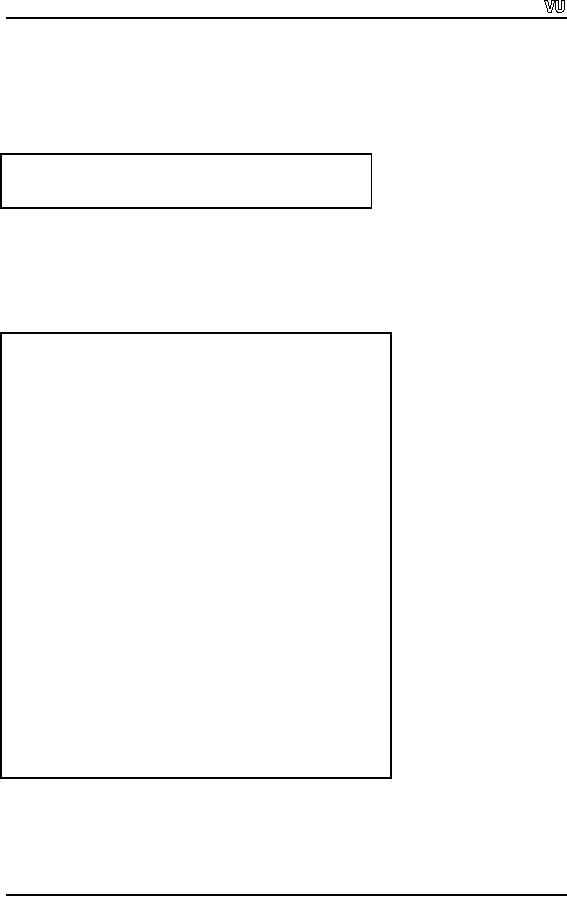
CS201
Introduction to Programming
if
(AmerAge
> AmaraAge )
{
cout
<< " Amer is older than
Amara";
}
A sample
execution of the program provides the
following output.
Please
enter Amer's age
16
Please
enter Amara's age
14
Amer is
older than Amara
Now
think what happens if the
condition in the if
statement
is not true i.e. Amer's age
is
not
greater than Amara's. In
this case, if the user
enters Amer's age less
than Amara's,
then
our program does nothing. So to check
this condition, another if
statement
after the
first
if
statement
is required. Then our program
will be as:
/* This
program checks the age of
Amer and Amara's
and
displays
the appropriate the message.
The program is using
two if
statements.*/
# include
<iostream.h>
main (
)
{
int
AmerAge, AmaraAge;
//prompt
the user to enter Amer's
age
cout
<< "Please enter Amer's
age " ;
cin
>> AmerAge;
//prompt
the user to enter Amara's
age
cout
<< "Please enter Amara's
age " ;
cin
>> AmaraAge;
//perform
the test
if
(AmerAge > AmaraAge )
{
cout
<< " Amer is older than
Amara";
}
if
(AmerAge < AmaraAge )
{
cout
<< " Amer is younger than
Amara";
}
}
Now
our program decides properly about
the ages entered by the
user.
After
getting ages from the user,
the if
statements
are tested and if statement
will be
executed
if the condition evaluates to
true.
Page
37
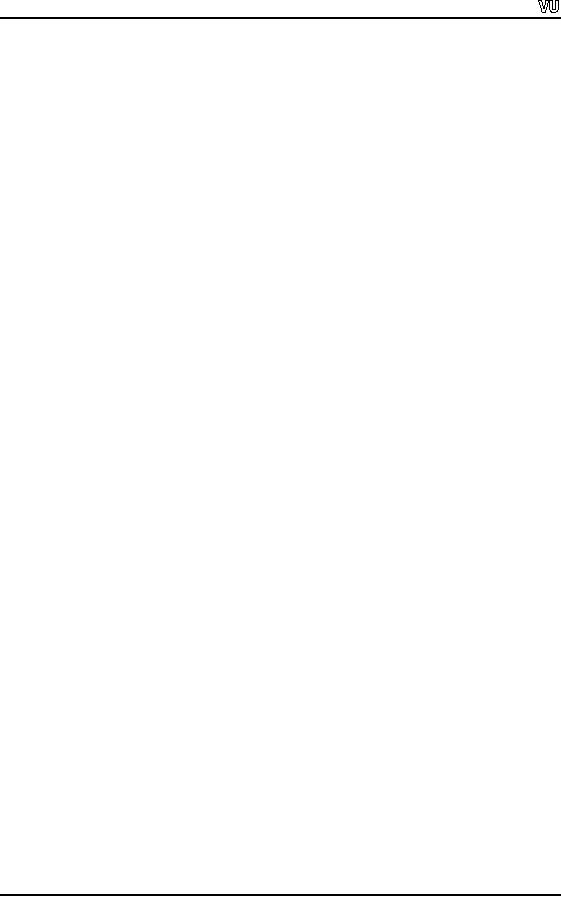
CS201
Introduction to Programming
If/else
Structure
We have
seen that the if
structure
executes its block of
statement(s) only when
the
condition
is true, otherwise the statements
are skipped. The if/else
structure allows the
programmer to specify
that a different block of
statement(s) is to be executed when
the
condition
is false. The structure of
if/else selection is as
follows.
if
(
condition)
{
statement(s);
}
else
{
statement(s);
}
Thus
using this structure we can
write the construct of our
program as
if
(AmerAge
> AmaraAge )
{
cout
<< " Amer is older than
Amara";
}
else
{
cout
<< " Amer is younger than
Amara";
}
In this
construct, the program checks
the condition in if
statement
.If the condition is
true,
then
the line "Amer is greater
than Amara" is printed. Otherwise (if
condition is not
true),
the
statement related to else
is
executed and the message
"Amer is younger than
Amara"
is printed. Here in
if/else structure an important
thing is that the else
part is executed for
all
the cases (conditions) other
than the case which is
stated in the if
condition.
And in
the comparison, we know that
there are three conditions i.e.
first value is
greater
than
the second value, first
value is less than the
second value and first
value is equal to
the
second value. Here in the
above program construct the
else part competes the
greater
than
conditions and covers both
less than and equal to
conditions.
Thus in
the above program construct,
the message "Amer is younger
than Amara" is
displayed
even if Amer's age is the
same as Amara's age. This is
logically incorrect and
so to
make this correct, we should
display the message "Amer is
younger than or is of
the
same
age as Amara". Now this
statement describes both the
cases other than the
one
`Amer is
greater than Amara'.
The
use of else saves us from
writing different if
statements
to compare different
conditions, in
this way it cover the
range of checks to complete the
comparison.
If we
want to state the condition
"Amer is greater than or is of
the same age as
Amara's"
then we
use the greater than or
equal to operator (i.e. >=) in
the if
statement
and less than
operator
( < ) in the else statement to
complete the comparison.
Page
38
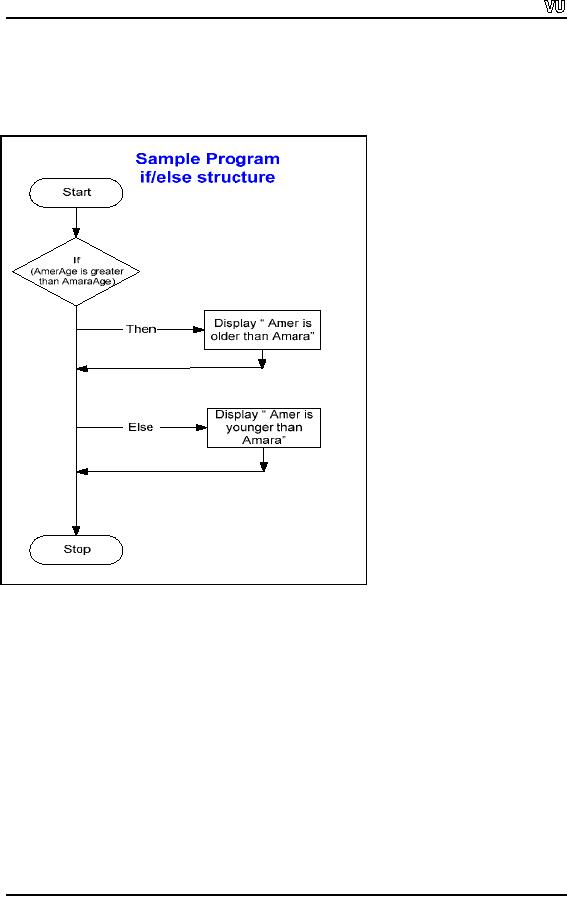
CS201
Introduction to Programming
It is
very important to check all
the conditions while making
decisions for good,
complete
and
logical results. Make sure
that all cases are
covered and there is no such
case in
which
the program does not
respond.
Logical
Operators
There
are many occasions when we
face complex conditions to make a
decision. This
means
that a decision depends upon more
than one condition in
different ways. Here we
combine
the conditions with AND or OR.
For example, a boy can be
selected in basket
ball
team only if he is more than 18
years old and has a height
of 6 feet. In this
statement
a boy
who wants to be selected in the
basket ball team must have
both the conditions
fulfilled.
This means that AND forces
both the conditions to be true.
Similarly we say
that a
person can be admitted to the
university if he has a BCS
degree OR BSC degree.
In
this
statement, it is clear that a
person will be admitted to the
university if he has any
one
of the
two degrees.
Page
39
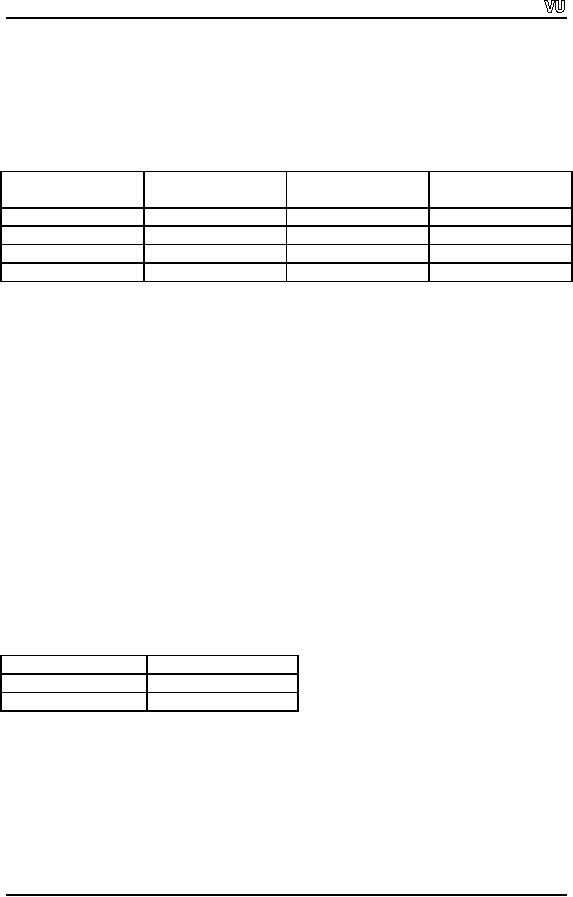
CS201
Introduction to Programming
In
programming we use logical
operators ( && and || ) for AND
and OR respectively
with
relational operators. These are
binary operators and take
two operands. These
operators
use logical expressions as
operands, which return TRUE
or FALSE.
The
following table (called truth table)
can be used to get the
result of the &&
operator
and ||
operator with possible
values of their operands. It is used to
explain the result
obtained
by the && and ||
operators.
Expression
1
Expression
2
Expression
1 &&
Expression
1 ||
Expression
2
Expression
2
True
False
false
True
True
True
true
True
False
False
false
False
False
True
false
True
The
&& operator has a higher
precedence than the ||
operator. Both operators
associate
from
left to right. An expressions containing
&& or || is evaluated only until
truth or
falsehood
is known. Thus evaluation of the
expression (age
> 18) && (height > 6) will
stop
immediately if age
> 18 is false
(i.e. the entire expression is
false) and continue
if
age
> 18 is true
(i.e. the entire expression could
still be true if the
condition height > 6 is
true
).
There is
another logical operator
that is called logical negation.
The sign ! is used for
this
operator.
This operand enables a programmer to
`reverse' the meaning of a
condition.
This is a
unary operator that has
only a single condition as an operand.
The operator ! is
placed
before a condition. If the
original condition (without
the ! operator) is false
then
the !
operator before it converts it to
true
and
the statements attached to
this are executed.
Look at
the following
expression
if ( !
(age > 18 ))
cout
<< " The age is less
than 18";
Here the
cout
statement
will be executed if the
original condition (age >
18) is false
because
the ! operator before it
reverses this false
to
true.
The truth
table for the logical
negation operator ( ! ) is given
below.
Expression
!
Expression
True
False
False
True
Page
40
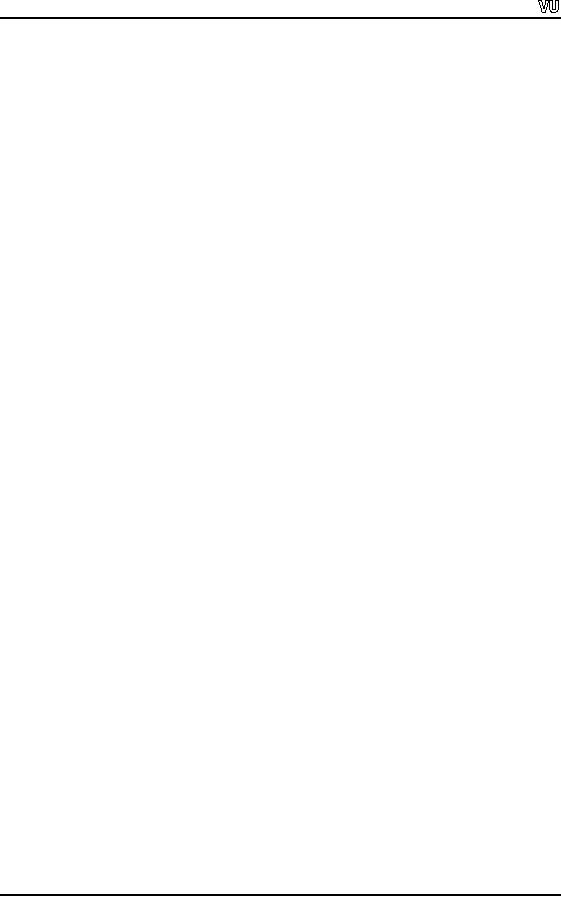
CS201
Introduction to Programming
Sample
Program 2
Problem
statement
A
shopkeeper announces a package
for customers that he will
give 10 % discount on all
bills
and if a bill amount is
greater than 5000 then a
discount of 15 %. Write a C program
which
takes amount of the bill
from user and calculates
the payable amount by
applying
the
above discount criteria and
display it on the
screen.
Solution
In this
problem we are going to make decision on
the basis of the bill
amount, so we will
be using
if
statement.
We declare three variables
amount, discount and netPayable
and
initialize
them. Next we prompt the
user to enter the amount of
the bill. After this
we
implement
the if
statement to test
the amount entered by the
user. As we see in
the
problem
statement that if the amount
is greater than 5000 then
the discount rate is 15 %
otherwise (i.e.
the amount is less than or
equal to 5000) the discount
rate is 10 %. So we
check
the amount in if
statement. If it is
greater than 5000 then
the condition is true
then
the if
block is executed otherwise if amount is
not greater than 5000
then the else block
is
executed.
The
analysis and the flow of
the program is shown by the following
flow chart.
Page
41
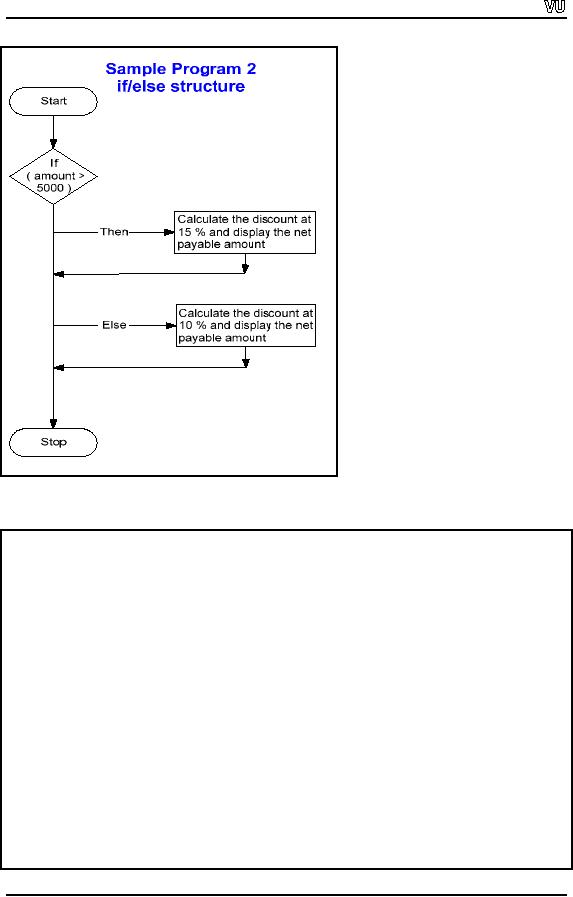
CS201
Introduction to Programming
The
complete program code is given below
:
/* This
program calculates the discount
amount for a customer. As
different discount
percentage
applies on different amount so program is
using if statement for
deciding
which
discount is applicable and display the
result. */
# include
<iostream.h>
main (
)
{
double
amount, discount, netPayable ;
amount =
0 ;
netPayable
= 0 ;
discount = 0
;
// prompt
the user to enter the
bill amount
cout
<< "Please enter the
amount of the bill "
;
cin
>> amount ;
//test
the conditions and calculate
net payable
if (
amount > 5000 )
{
Page
42
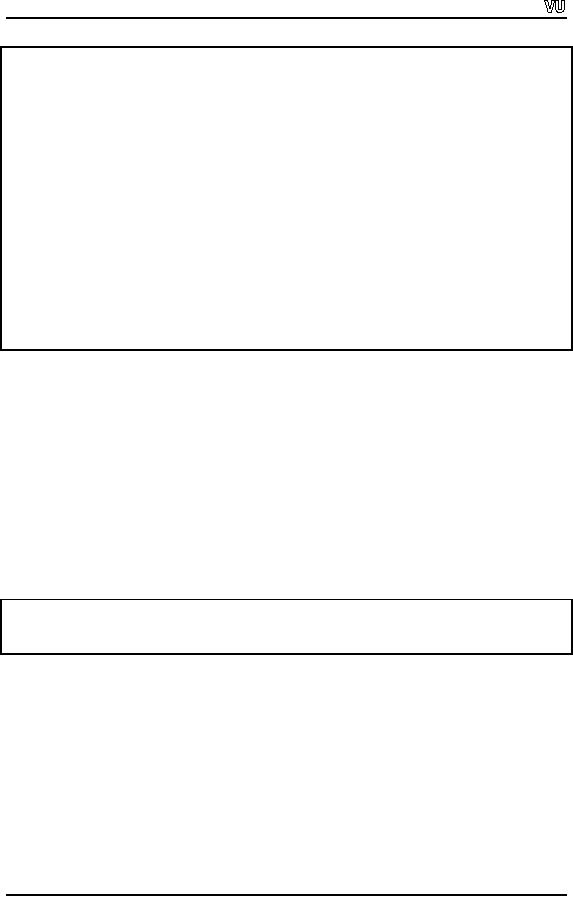
CS201
Introduction to Programming
//calculate
amount at 15 % discount
discount =
amount * (15.0 / 100);
netPayable
= amount - discount;
cout
<< "The discount at the rate 15 %
is Rupees " << discount <<
endl;
cout
<< "The payable amount is
Rupees " << netPayable
;
}
else
{
//
calculate amount at 10 % discount
discount =
amount * (10.0 / 100);
netPayable
= amount - discount;
cout
<< "The discount at the rate 10 % is
Rupees " << discount << endl
;
cout
<< "The payable amount is
Rupees " << netPayable ;
}
}
In the
program we declared the variables as
double.
We do
this to get the correct
results
(results
may be in decimal points) of the
calculations. Look at the statement
which
calculates
the discount. The statement
is
discount =
amount * (15.0 / 100)
;
Here in
the above statement we write
15.0
instead
of 15. If we
write here 15
then
the
division
15 /
100 will be
evaluated as integer division
and the result of division
(0.15)
will be
truncated and we get 0 and
this will result the
whole calculation to zero. So it
is
necessary
to write at least one
operand in decimal form to
get the correct result
by
division
and we should also declare
the variables as float
or
double. We do
the same in
the
line discount = amount * (10.0 /
100);
A sample
execution of the program is given
below
Please
enter the amount of the
bill
6500
The
discount at the rate 15 % is
Rupees
975
The
payable amount is
Rupees
5525
Tips
·
Always
put the braces in an if/else
structure
·
Type the
beginning and ending braces
before typing inside them
·
Indent
both body statements of an if
and
else
structure
·
Be careful
while combining the conditions
with logical
operators
·
Use if/else
structure
instead of a number of single selection
if statements
Page
43
Table of Contents:
- What is programming
- System Software, Application Software, C language
- C language: Variables, Data Types, Arithmetic Operators, Precedence of Operators
- C++: Examples of Expressions, Use of Operators
- Flow Charting, if/else structure, Logical Operators
- Repetition Structure (Loop), Overflow Condition, Infinite Loop, Properties of While loop, Flow Chart
- Do-While Statement, for Statement, Increment/decrement Operators
- Switch Statement, Break Statement, Continue Statement, Rules for structured Programming/Flow Charting
- Functions in C: Structure of a Function, Declaration and Definition of a Function
- Header Files, Scope of Identifiers, Functions, Call by Value, Call by Reference
- Arrays: Initialization of Arrays, Copying Arrays, Linear Search
- Character Arrays: Arrays Comparisonm, Sorting Arrays Searching arrays, Functions arrays, Multidimensional Arrays
- Array Manipulation, Real World Problem and Design Recipe
- Pointers: Declaration of Pointers, Bubble Sort Example, Pointers and Call By Reference
- Introduction, Relationship between Pointers and Arrays, Pointer Expressions and Arithmetic, Pointers Comparison, Pointer, String and Arrays
- Multi-dimensional Arrays, Pointers to Pointers, Command-line Arguments
- String Handling, String Manipulation Functions, Character Handling Functions, String Conversion Functions
- Files: Text File Handling, Output File Handling
- Sequential Access Files, Random Access Files, Setting the Position in a File, seekg() and tellg() Functions
- Structures, Declaration of a Structure, Initializing Structures, Functions and structures, Arrays of structures, sizeof operator
- Bit Manipulation Operators, AND Operator, OR Operator, Exclusive OR Operator, NOT Operator Bit Flags Masking Unsigned Integers
- Bitwise Manipulation and Assignment Operator, Programming Constructs
- Pre-processor, include directive, define directive, Other Preprocessor Directives, Macros
- Dynamic Memory Allocation, calloc, malloc, realloc Function, Dangling Pointers
- History of C/C++, Structured Programming, Default Function Arguments
- Classes and Objects, Structure of a class, Constructor
- Classes And Objects, Types of Constructors, Utility Functions, Destructors
- Memory Allocation in C++, Operator and Classes, Structures, Function in C++,
- Declaration of Friend Functions, Friend Classes
- Difference Between References and Pointers, Dangling References
- Operator Overloading, Non-member Operator Functions
- Overloading Minus Operator, Operators with Date Class, Unary Operators
- Assignment Operator, Self Assignmentm, Pointer, Conversions
- Dynamic Arrays of Objects, Overloading new and delete Operators
- Source and Destination of streams, Formatted Input and Output, Buffered Input/Output
- Stream Manipulations, Manipulators, Non Parameterized Manipulators, Formatting Manipulation
- Overloading Insertion and Extraction Operators
- User Defined Manipulator, Static keyword, Static Objects
- Pointers, References, Call by Value, Call by Reference, Dynamic Memory Allocation
- Advantages of Objects as Class Members, Structures as Class Members
- Overloading Template Functions, Template Functions and Objects
- Class Templates and Nontype Parameters, Templates and Static Members
- Matrices, Design Recipe, Problem Analysis, Design Issues and Class Interface
- Matrix Constructor, Matrix Class, Utility Functions of Matrix, Input, Transpose Function
- Operator Functions: Assignment, Addition, Plus-equal, Overloaded Plus, Minus, Multiplication, Insertion and Extraction